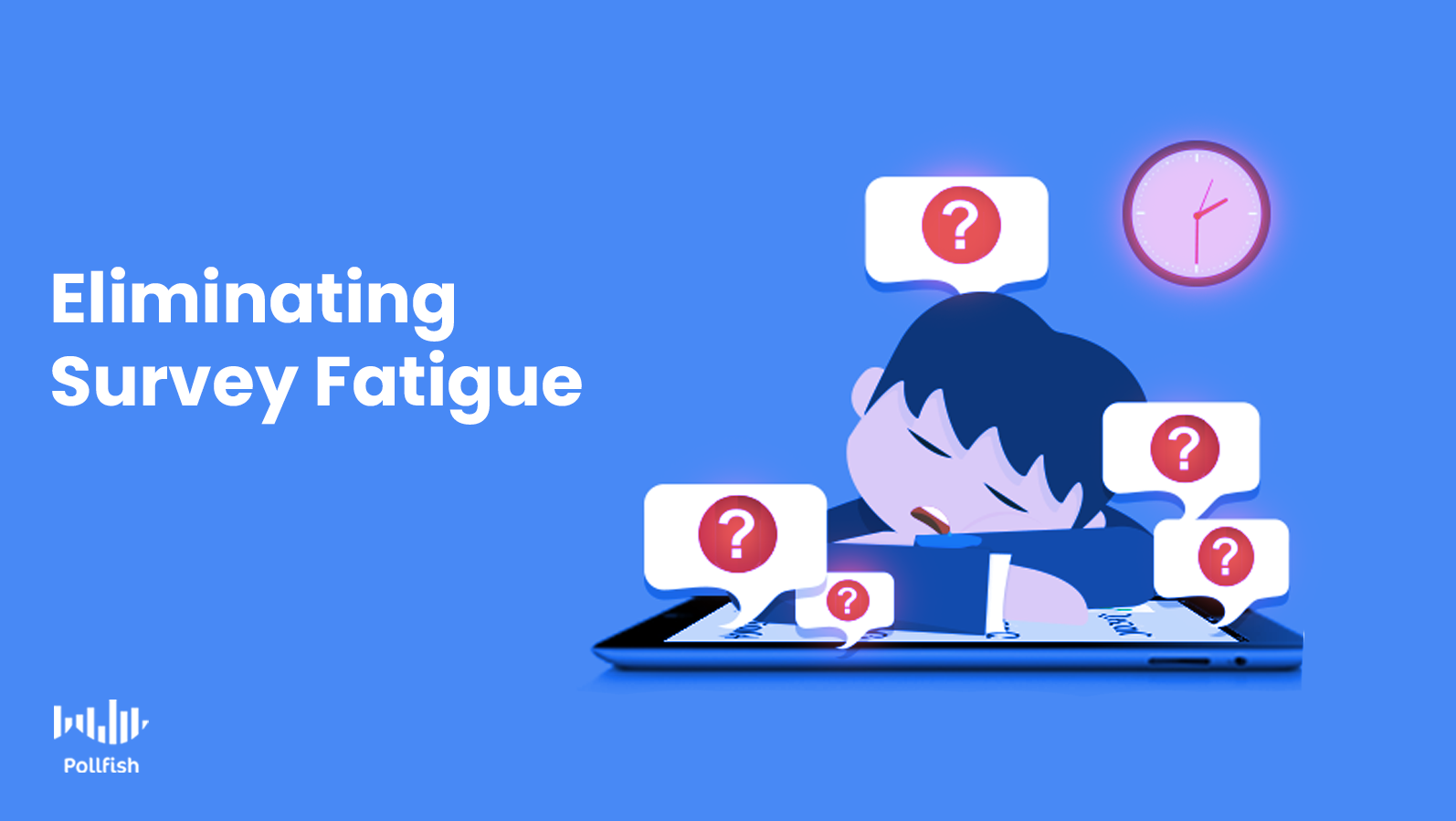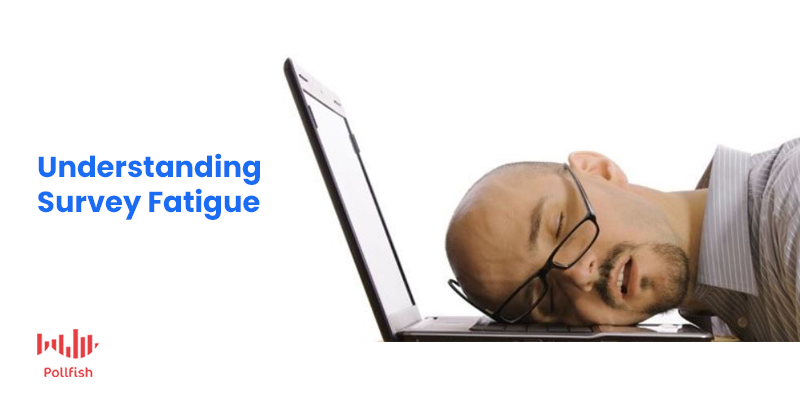How to Minimize Survey Fatigue for Quality Research

Although survey respondents from far and wide have undergone different experiences, they’ve all come upon one regrettable issue: survey fatigue. This phenomenon is one of the greatest detriments to survey research, as it hampers respondents who already have begun participating in a survey.
Valuable survey responses are hard enough to come by as it is, so when your respondents are hit with a bout of survey fatigue, it makes it even more difficult to retrieve needed responses.
This is because respondents who experience survey fatigue are less inclined to complete their survey, or do so in an accurate manner.
This article explains survey fatigue, including its four different types and how to minimize them so your survey research is never blighted by low-quality responses.
Defining Survey Fatigue
This occurrence denotes the phenomenon in which survey respondents become exhausted, bored or uninterested with a survey they’re taking or are about to take. This incurs several problems for survey research, in that when respondents are fatigued, the quality of their responses tarnishes.
The Two Main Types of Survey Fatigue
 Eliminating this negative phenomenon hinges on understanding where and how it occurs. First, you ought to know that there are two main manifestations of survey fatigue.
Eliminating this negative phenomenon hinges on understanding where and how it occurs. First, you ought to know that there are two main manifestations of survey fatigue.
- Pre-Survey Response Fatigue: This takes place before prospective respondents take a survey. This kind of fatigue comes about due to repeated requests to take a survey. Sending too many prompts or reminders can thus cause this kind of fatigue.
- It is the chief cause of a low survey response rate.
- Fatigue During the Survey: This occurs as respondents are taking their surveys and can be caused by a variety of in-survey issues. As such, researchers should consider several practices to create effective surveys.
- This kind of fatigue is responsible for survey abandonment during the survey-taking process.
How Survey Fatigue is Damaging to Businesses
Survey fatigue is not merely a problem for survey respondents, who can certainly do without feeling fatigued from a tool that ultimately benefits its creators, i.e., the researchers. It is generally best to avoid surveys prone to cause fatigue, as online respondents will associate negative feelings towards surveys and be disinclined to take them again, even when offered with survey incentives.
Here are a few other main ways that survey fatigue damages not merely your survey research, but your business, by extension.
- Tarnished answers: Fatigue naturally leads to poor quality answers. This outcome is extremely damaging to survey data quality. There are a number of ways that fatigue creates substandard answers. Here are a few examples:
- Survey biases such as acquiescence bias, flatlining, random response bias and many more.
- Gibberish answers to quickly complete the survey.
- Answers with little to no thought on the questions, thus inaccurate or not fully representative of the respondents’ true opinions and experiences.
- Skipping open-ended questions or answering them with one word just to rush through the survey.
- Survey attrition: The most severe instance of survey fatigue will lead to survey attrition, in which respondents abandon their surveys, rendering them incomplete and since they’ve not been submitted, useless. Survey attrition also refers to nonresponse attrition, which refers to the first type of survey fatigue, in which would-be respondents do not take part in a survey. This form of attrition is called nonresponse attrition.
- Waste of resources and money: Whether you hire a survey panel or run online surveys, surveys bound to generate fatigue waste the efforts of your respondents. It’s best not to trouble respondents as they are part of your target market, or target population. As aforementioned, a bad survey experience will repel them from taking part in future surveys, which is damaging since you either selected them (in panels) or managed to get them to participate via an online survey. Regardless of whichever method you brought them to your survey, fatiguing them wastes time and money.
- Negative Perceptions of your business: Fatigue does not simply cause negative associations with surveys, but it posits your brand in a negative light. This is especially true for B2B brands, as B2B surveys are targeted to partners and existing business clients, who are obviously aware of the brand behind the survey. Even leads will form an opinion of your brand, as they often land on surveys via a digital experience with your brand. B2C brands may also suffer poor brand perceptions by way of survey fatigue, as some surveys will require mentioning the brand and its operations. Ex: in a survey measuring an ad or marketing campaign, or in a customer feedback survey.
The Causes of Survey Fatigue & How to Avoid Them
There are several factors at play when it comes to this phenomenon. The most evident cause is a poorly formed survey. Whether it is the question structure of the survey, the nature of the questions themselves, or poor targeting, these unfavorable structural elements all contribute to survey fatigue. The following are some critical causes to consider, as they all factor into survey fatigue.
- Incorrect targeting: you may set specific demographics quotas to your survey, but are they correct? You ought to understand your target market to a T before sending them any surveys. If the content of the surveys feels irrelevant, respondents will easily incur survey fatigue. Solutions:
- Study your target market via secondary and primary research before sending surveys aimed at them, especially if you operate a niche business and the survey is in relation to a niche subject matter.
- Conduct market segmentation to divide your target market into even smaller segments. This way, you can send relevant surveys catered to each type.
- Long questionnaires: Some surveys require more questions than others. However, long questionnaires tend to be tiresome and quickly cause respondents to disengage. Also, if some interruption occurs (spotty Wifi, etc.), all their responses will be gone and they’ll be reluctant to restart and go through the entire process. Solutions:

- Keep surveys as short as possible.
- Break up a long survey into smaller ones when possible.
- Offer incentives and an estimated completion time to respondents.
- Over-surveying: Continuous prompts for respondents to take part in surveys can be bothersome. As such, this may cause both of the survey fatigue types, as respondents will be too bored to begin a survey and may become bored while taking one, when they’ve done so several times. Solutions:
- Consider the need for your surveys; if it is not all that necessary, eschew it.
- If you require follow-up surveys to the exact same panel, consider planning out how many surveys you’ll need and letting the panelists know in advance.
- Repetitive questions: These will frustrate and bore your respondents, not to mention, make the survey longer than it needs to be. Solutions:
- Avoid using Matrix questions consecutively.
- Route users to appropriate questions via skip logic.
- Keep questions as disparate as possible, unless they’re follow-up questions respondents get via skip logic.
How to Minimize Survey Fatigue
There are plenty of other causes of this kind of survey repellent. Even the most vigilant researcher can fall prey to creating a fatigue-inducing survey. This is because getting bored is part of human nature, so plenty of respondents may inadvertently experience some level of fatigue.
To combat survey fatigue, here are a few considerations and best practices to put into use that are not mentioned in the previous section with solutions.
- Be concise with questions. Do not cram two inquiries into one. They may be related, but this forces the respondent to think more and can lead to feeling overwhelmed.
- Ex: Instead of asking: “Which brands have you heard about and which is the best one in your opinion?”
- Form two questions: “Which brand have you heard of?” Use skip logic if they’ve heard of at least two to the following question: “Which is the best one in your opinion?”
- Provide all possible answers if you’re using multiple-choice questions. However, keep this to a minimum if you’re using a scaled or Matrix question.
- Leave no ambiguity on your questions. If your questions or answers leave respondents scratching their heads, they’ll unlikely care to finish their surveys, let alone truthfully.
- Limit open-ended questions. Open text fields require writing, something many respondents will be hesitant to do, especially if pressing a button in a multiple-choice becomes too laborious for them.
- Be consistent with scaled questions. Avoid confusion by keeping scales consistent. For example, if you choose a 5-point Likert scale, keep it at five points throughout. Don’t mix and match scaled questions.
- Ex: If the following is used in one answer range;
- Extremely satisfied
- Somewhat satisfied
- Neither satisfied nor dissatisfied
- Somewhat dissatisfied
- Extremely dissatisfied
- Then the following answers should follow suit
- Keep the language consistent with the target market/population. Some populations will understand professional terms and jargon, while others won’t.
- The same applies when surveying different generations in the same survey; if the lingo is only understood by one demographic, do not use it in a survey with various demographics, as they may not understand it. Looking up terms while taking a survey can lead directly to fatigue.
- Keep surveys culturally relevant. Do not ask the same questions to members of different countries, geographical districts and cultures, as fatigue will inevitably ensue.
- Ex: listeners of pop music may not know anything about country.
Relying on a Potent Online Survey Tool
Using a strong online survey tool is the best solution for eliminating survey fatigue. This is because a valuable online survey platform offers various ways to structure questions, provides quality checks (for example, on gibberish or flatlining answers, etc.), avoids survey fraud and allows you to thoroughly screen respondents so only the most relevant ones take part.
These aspects cannot be provided with survey panels alone.
Additionally, researchers ought to be heedful of the online survey platforms they choose. After all, the survey experience is at the heel of the platform. A strong survey platform can avoid fatigue, even when rookie researchers set out on their first survey campaign.
Frequently asked questions
What is survey fatigue?
Survey fatigue is the phenomenon where survey respondents lose interest in the survey they are taking, reducing the attention they pay to the questions, causing them to provide inaccurate answers and at worse, survey attrition .
What are the two types of survey fatigue?
The two types of survey fatigue are pre-survey response fatigue and fatigue during the survey. Pre-survey response fatigue usually results from overspending prompts and reminders. Fatigue during the survey often results from in-survey issues.
How does survey fatigue damage businesses?
Survey fatigue can lead to tarnished answers, survey attrition, waste of resources and money, and a negative perception of your business. Plus, online respondents will be less likely to take surveys in the future if they have a negative experience.
What causes survey fatigue?
Survey fatigue is most often the result of poorly created surveys. Specific causes can include incorrect targeting, long questionnaires, over-surveying and repetitive questions.
How can you minimize survey fatigue?
You can minimize survey fatigue through the following methods: being concise with your questions, providing all possible answers (in the case of multiple- choice questions), avoiding ambiguity, limiting open-ended questions, being consistent with scaled questions, keeping language consistent with your target market/population and keeping surveys culturally relevant.
Pollfish Marketing Team
Ready to Try Pollfish?
Create your survey with AI, target high-quality respondents starting at $0.95 per complete, and start getting results in just minutes in real-time. From running a simple product concept survey to managing a constant stream of trackers for dozens of clients in dozens of countries, we’ve got you.

